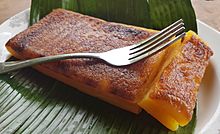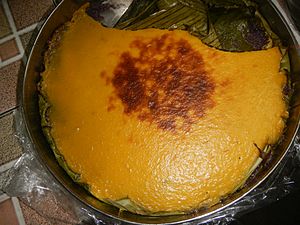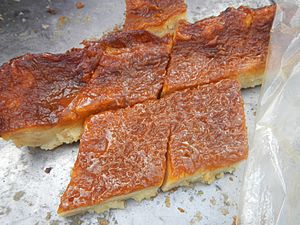Cassava cake facts for kids
  |
|
| Alternative names | cassava pudding, cassava pie, cassava bibingka, bibingkang kamoteng kahoy, bibingkang balanghoy, budin |
|---|---|
| Course | Dessert |
| Place of origin | Philippines |
| Serving temperature | room temperature |
| Similar dishes | Bánh khoai mì, Bibingka, Pilawpinan mont |
Cassava cake is a yummy and popular dessert from the Philippines. It's a moist cake made from grated cassava, which is a root vegetable. This delicious cake also includes coconut milk and condensed milk. It usually has a creamy custard layer on top. People in the Philippines often enjoy cassava cake as a snack, called merienda. It's also a favorite treat for parties and special events.
Contents
Discovering Cassava Cake's History
Cassava is a root vegetable that came to the Philippines a long time ago. It arrived from Latin America on big ships called Manila galleons, starting in the 1500s. Cassava cake is a special kind of bibingka. Bibingka are traditional baked cakes in the Philippines. Originally, bibingka was made with ground glutinous rice. But people started using cassava instead, creating the yummy cassava cake we know today.
Sometimes, cassava cake is also called cassava bibingka, or bibingkang kamoteng kahoy. However, the English name "cassava cake" is more common. In a place called Quezon, this cake has another name: budin.
What is Cassava Cake Made Of?
Cassava cake is made by mixing grated cassava with gata, which is coconut milk. It also has condensed milk and egg whites. Some recipes might add butter (or margarine), vanilla, evaporated milk, and extra sugar. This mixture is poured into a baking pan. The pan is often lined with banana leaves or simply greased. The cake is then baked until it's firm and light brown.
You can change how soft or firm the cake is. If you use less grated cassava, the cake will be softer and moister. If you use more cassava, it will be firmer and a bit chewy.

The creamy topping for cassava cake is usually made separately. It's a traditional coconut-based custard. This custard is made with egg yolks, condensed milk, sugar, and kakang gata (which is coconut cream). This delicious custard is poured over the baked cake. Then, the cake is baked again for a few more minutes. This second baking helps the top layer become solid.
The thickness of the custard layer can be different. Some cakes have a very thin layer, while others have a thick layer, almost as thick as the cake itself! Today, some people use milk-based custard if coconut cream isn't available. Also, some versions don't have a baked top layer at all.
Before the second baking, other yummy toppings can be added. These might include cheddar cheese, macapuno strings (a type of coconut), or grated coconut. After baking, the cake might be decorated with more grated cheese or latik (fried coconut milk solids). The cakes are then cooled down and cut into squares to serve.
It's important to know that raw cassava can be harmful because it has a natural chemical called cyanogenic glucoside. Most cassava in the Philippines is a "sweet" type, which has less of this chemical. But it's always important to make sure cassava is cooked properly before eating it.
Different Kinds of Cassava Cake
Cassava cake can be changed by adding different ingredients. One common type is "cassava buko bibingka", which includes young coconut called buko. Another popular one is "pineapple cassava bibingka", which has crushed pineapple pieces.
In a place called Vigan, Ilocos Sur, there's a local version called "royal bibingka". These are shaped like small cupcakes. They often have a tasty topping of cheese and margarine.
Cakes Like Cassava Cake
Cassava cake is quite similar to a Vietnamese dessert called bánh khoai mì. This Vietnamese cake is sometimes also called "cassava cake" in English. However, bánh khoai mì does not use milk and doesn't have a custard topping. Cassava cake also looks a bit like Caribbean and African cassava pone (also known as yuca cake). But cassava pone is usually thicker and drier.



